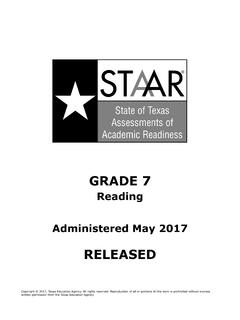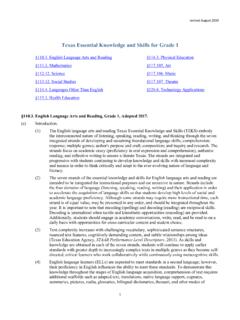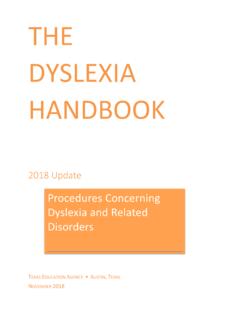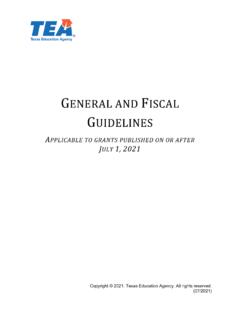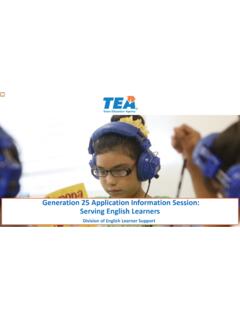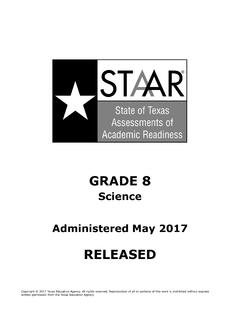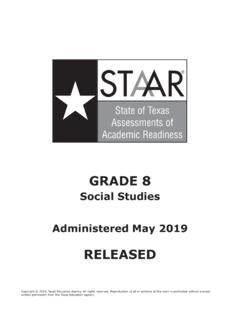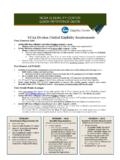Transcription of Disciplinary Alternative Education Program Practices
1 Policy Research Disciplinary Alternative Education Program Practices Since adoption of the Texas Safe Schools Act in 1995, all Texas public school districts have been required to provide Disciplinary Alternative Education programs (DAEPs). DAEPs serve as Alternative Education settings for students temporarily removed for Disciplinary purposes from their regular instructional settings. This report presents an overview of Program characteristics and Practices described in selected research as best Practices in Disciplinary Alternative Education settings. In addition, the report provides a policy history of Disciplinary Alternative Education , a summary of statutory requirements related to DAEPs, and statewide statistics on DAEP assignments. Report Number 17, August 2007. Division of Accountability Research Department of Assessment, Accountability, and Data Quality Texas Education Agency Texas Education Agency Robert Scott, Acting Commissioner of Education Lizzette Reynolds, Acting Deputy Commissioner for Statewide Policy and programs Department of Assessment, Accountability, and Data Quality Criss Cloudt, Associate Commissioner Office of Data Development, Analysis, and Research Patricia Sullivan, Deputy Associate Commissioner Division of Accountability Research Karen Dvorak, Director Project Staff Sue E.
2 Mutchler Richard Kallus Amanda Callinan Reviewers Rachel Harrington, Division of Performance-Based Monitoring Linda Roska, Division of Accountability Research Shawn Thomas, Division of Accountability Research Citation. Texas Education Agency. (2007). Disciplinary Alternative Education Program Practices . Policy Research Report No. 17 (Document No. GE07 601 11). Austin, TX: Author. Abstract. Texas public school districts have been required to provide Disciplinary Alternative Education pro- grams (DAEPs) since the 1996-97 school year. DAEPs serve two main purposes: to provide temporary disci- plinary settings for disruptive students and to meet the basic academic and behavioral needs of students assigned to the programs . This report presents an overview of Program characteristics and Practices described in selected research as "best Practices " in Disciplinary Alternative Education settings. In addition, the report provides a policy history of Disciplinary Alternative Education , a summary of statutory requirements related to DAEPs, and statewide statistics on DAEP assignments.
3 Keywords. Alternative Education , DAEP, Disciplinary Alternative Education , school discipline, school safety, school violence. Additional copies of this document may be purchased using the order form in the back of this publication. Also, the report is available in PDF format on the agency website at Ad- ditional information about this report may be obtained by contacting the Texas Education Agency Division of Accountability Research by phone at (512) 475-3523, by e-mail at or via the divi- sion website at Copyright Notice. The materials are copyrighted and trademarked as the property of the Texas Education Agency (TEA) and may not be re- produced without the express written permission of TEA, except under the following conditions: (1) Texas public school districts, charter schools, and Education Service Centers may reproduce and use copies of the Materials and Related Materials for the districts' and schools' educational use without obtaining permission from TEA; (2) residents of the state of Texas may reproduce and use copies of the Materials and Related Materials for individual personal use only without obtaining written permission of TEA; (3) any portion reproduced must be reproduced in its entirety and remain unedited, unaltered and unchanged in any way; and (4) no monetary charge can be made for the reproduced materials or any document containing them.
4 How- ever, a reasonable charge to cover only the cost of reproduction and distribution may be charged. Private entities or persons located in Texas that are not Texas public school districts, Texas Education Service Centers, or Texas charter schools or any entity, whether public or private, educational or non-educational, located outside the state of Texas MUST obtain written approval from TEA and will be required to enter into a license agreement that may involve the payment of a licensing fee or a royalty. For information contact: Office of Copyrights, Trademarks, License Agreements, and Royalties, Texas Education Agency, 1701 N. Congress Ave., Austin, TX 78701-1494; phone 512-463-9270 or 512-936-6060; email: Disciplinary Alternative Education Program Practices Introduction their assigned schools (Institute for the Study of Since adoption of the Texas Safe Schools Act Students at Risk [ISSR], 2001; Kleiner, Porch, &. in 1995, all Texas public school districts have Farris, 2002; Zweig, 2003).
5 Been required to provide Disciplinary Alternative Disciplinary Alternative Education differs from Education programs (DAEPs). DAEPs serve as al- other kinds of Alternative Education primarily in ternative Education settings for students temporar- method of student placement and Program pur- ily removed for Disciplinary purposes from their pose. Students are placed in Disciplinary alterna- regular instructional settings. Chapter 37 of the tive Education settings after removal from their Texas Education Code (TEC, 2005) stipulates that assigned classrooms or schools, and attendance is school districts must meet the educational and be- compulsory for prescribed periods of time. En- havioral needs of students assigned to DAEPs but rollment in nondisciplinary Alternative Education leaves Program design and content to local discre- programs is by choice, typically requiring students tion. to apply to attend the programs rather than their Although considerable research is available on assigned schools.
6 Alternative Education in general, only recently The purpose of Disciplinary Alternative educa- have studies begun to focus specifically on disci- tion is to provide temporary student placements plinary forms of Alternative Education . This report for behavior management, often as alternatives to presents an overview of Program characteristics suspension or expulsion. The goal is for students and Practices described in selected research as to return to, and succeed in, their regularly as- "best Practices " in Disciplinary Alternative educa- signed classrooms and schools. The purpose of tion settings. In addition, the report provides a pol- nondisciplinary Alternative Education is to create icy history of Disciplinary Alternative Education , full-time, voluntary educational programs for stu- a summary of statutory requirements related to dents who have not been succeeding in traditional DAEPs, and statewide statistics on DAEP schools. The expectation is that students in non- assignments.
7 Disciplinary settings will continue in the programs through graduation (Academic Information Man- agement, Inc., 2001; Aron, 2006; ISSR, 2001;. Definitions of Disciplinary Lange & Sletten, 2002; McCreight, 1999; Moore Alternative Education & King, 2005; Raywid, 1994; Ruzzi & Kraemer, 2006). Definitions in Research Disciplinary Alternative Education is a rela- Definition in Texas Statute tively new form of Alternative Education . In the TEC Chapter 37 defines DAEPs by physical 1970s, school districts across the United States be- setting and a limited set of requirements associated gan to establish Alternative Education programs with curriculum and teachers. Each DAEP must: and schools for student populations considered to be at risk of school failure or dropping out. Since be provided in a setting other than a student's the passage of the federal Gun Free Schools Act of regular classroom;. 1994, Alternative Education programs have been separate students assigned to the Program created for a more specific group of students from those not assigned to the Program .
8 Those who have violated local or state-mandated rules of conduct or have been determined to be focus academically on English language arts, disruptive to the Education of other students in mathematics, science, history, and self- discipline;. Policy Research Report No. 17, August 2007 1. provide for the educational and behavioral students to be removed from schools not only for needs of students; gun possession, but for a broader range of behav- iors, including: possession, distribution, or use of provide supervision and counseling;. alcohol or drugs; physical attacks or fights;. require each teacher in the Program to be certi- chronic truancy; possession or use of weapons fied in accordance with TEC Chapter 21, Sub- other than firearms; and disruptive verbal behavior chapter B; and (Zweig, 2003; Kleiner, Porch, & Farris, 2002). require each teacher in the Program with a In 1993, under Senate Bill 7, the 73rd Texas special Education assignment to be appropri- Legislature created the Joint Select Committee to ately certified or permitted for the assignment.
9 Review the Central Education Agency. Among A DAEP may be located on or off of a regular other issues, the committee studied programs de- campus and may be provided jointly by more than signed for students at risk of school failure, includ- one school district. A school district must allocate ing students found to be disruptive to the to a DAEP the same expenditure, including fed- Education of other students (Joint Select Commit- eral, state, and local funds, per student attending tee to Review the Central Education Agency, the DAEP that would be allocated to the student's 1994). Committee recommendations for address- school if the student were attending his or her ing the behaviors of "seriously and habitually dis- regularly assigned Education Program , including a ruptive students" (p. 20) included establishment of special Education Program . a statewide zero-tolerance discipline policy that would provide schools and districts broader au- Academically, the mission of a DAEP is to thority to remove students from regular Education enable students to perform at grade level.
10 A school settings. To counter the trend of expelling disrup- district must offer a student removed to a DAEP tive students from school and sending them "to the an opportunity to complete coursework before the streets" (p. 18), the committee also recommended beginning of the next school year at no expense to that all districts provide access to Alternative edu- the student. The opportunity may be provided cation settings for students removed from regular through any method available, including corre- Education settings. spondence course, distance learning, or summer school. A school district may choose to provide a In 1995, the legislature passed Senate Bill 1, Program of educational and support services to which established a system of Alternative educa- a student and the student's parents when the of- tion that allowed for both the removal and contin- fense involves drugs or alcohol as specified under ued Education of students whose behaviors TEC or A DAEP that provides violated local or state-mandated rules of conduct.
